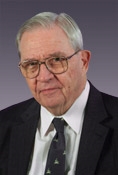
Dr. D.A. Henderson
On Sept. 16, 2001, five days after 9/11, Dr. D.A. Henderson, distinguished scholar at the Center for Biosecurity at U.P.M.C. and a professor of medicine and public health at the University of Pittsburgh, was summoned to Washington, D.C., to meet with some of the nation's top security and public health officials.
There was reason to believe, Dr. Henderson was told, that another attack was coming, and it would possibly be biologic in nature. If that attack involved smallpox, they wanted to know, what kind of damage could it inflict?
The news was not good.
"We had about 75 percent of the population susceptible and only about 90,000 doses of the vaccine available," Dr. Henderson said. "We had no one currently manufacturing the vaccine and about a five-year wait before we'd have more doses ready."
Thankfully, that second attack never came, but Dr. Henderson did well to illustrate just how unprepared the nation would be if smallpox — a disease that had been eradicated in the U.S. in 1949 and seen its last reported case worldwide in 1977 — were to resurface.
On Tuesday, Oct. 20, Dr. Henderson visited Weill Cornell Medical College to discuss smallpox at the B.H. Kean–Boxer Family Foundation Lecture in Global Health. Dr. Henderson, who in 1967 was tapped to lead the World Health Organization's efforts to eradicate smallpox, recently wrote a book about the global fight against the disease, "Smallpox: The Death of a Disease."
In 1967, there were 43 countries around the world reporting cases of smallpox. Two million people had already died from the disease. There was a vaccine, but the process of administering it was slow and expensive, and the spread of the disease was quickly outpacing the supply.
The bifurcated needle, introduced not long after Dr. Henderson began work on the global vaccination project, represented the turning point in the fight against smallpox. Only a quarter of the previous amount of vaccine was needed. The needles could be sterilized and reused and anyone could be trained to administer the vaccine.
"We could train a village to do this in 15 minutes," Dr. Henderson said. "You could drop your needles in a bucket, boil them for 20 minutes and be ready to go again the next day."
The plan to vaccinate 80 percent of the population and then monitor the disease and coordinate immediate containment efforts if it resurfaced worked exceedingly well for the majority of the world.
But smallpox proved to be more formidable in India, where the population was highly mobile. The WHO sent 120,000 people to vaccinate every person in every village it could find in a 10-day period. This was done twice a month, and by 1974 true progress was being made. More obstacles, in the form of the gasoline crisis, massive labor strikes and devastating flooding, thwarted the vaccination efforts. But on Aug. 15, 1975, the 28th anniversary of India's independence from British rule, the country was declared smallpox-free for the first time in written history.
That left Ethiopia and Somalia as the last corners of the earth where smallpox was still hiding.
In Ethiopia — a nation of 25 million people at the time — vaccination teams were kidnapped by revolutionaries on nine separate occasions. They also captured a helicopter — though, Dr. Henderson points out, the pilot, who was later released, was able to vaccinate his captors.
The last stand came in 1970 in Somalia, whose population is predominantly Muslim, when a pilgrimage to Mecca threatened to trigger another global smallpox outbreak. Dr. Henderson and his team were able to eradicate the disease before it could spread further, and in 1980 the World Health Assembly declared the global end of smallpox.
Smallpox, of course, still exists in laboratories, and in 1992, it was revealed that the former Soviet Union was experimenting with putting smallpox, anthrax and plague in the warheads of missiles.
In response to a possible biologic attack involving smallpox, the U.S. now has more than 200 million doses of the vaccine and strengthened rapid-response capability.

